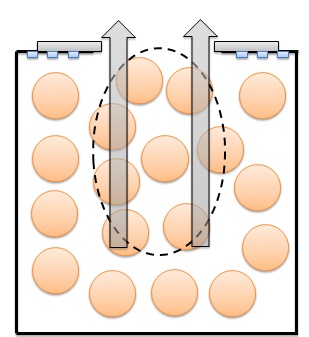Hey guys,
Like I said; I will try to write some more posts even though they are not as in-depth or as culturally deep as other posts I have (at least that is my impression) posted here on my blog (I like telling myself that I write some pretty deep and intense stuff . . . ). Today I want to talk about riding an elevator in Japan. It is an Art. It is hard and uncomfortable. But maybe I can prepare you guys for the things to come should you ever be stuck with 25 Japanese サラリーマン (sarariiman – Which literally means “salary man” and is just the general term for some employee who has to wear a suit and a necktie to work -> white collar) in a room barely 2 by 2 meters for the next 40 floors.
Before I start I want to remind you guys that their are ALWAYS exceptions! Not all Japanese are the same. But there is stuff they teach you and you better do it. But like always it depends very much on the situation you are in at the current moment.
First of all: Don’t talk!
At the beginning here in the training, I was painfully reminded (EVERYDAY) that it is a “No-Go” (Or like Japanese say: “NGです” – It is NG) to talk in the elevator. While I personally think the reason is not to disturb someone else who doesn’t want to hear your verbal vomit, the company’s reason was: “You will talk about internal information and our clients and you cannot do that!” They also told our Chinese co-workers not to talk in Chinese because some people might understand it. Spies are everywhere!
– When you are with your direct friends ONLY in the elevator, you can talk (at least that is what I do).
– When you are with your direct friends and a stranger in the elevator, you can whisper occasionally to one another.
– When you are with your direct friends and strangers in the elevator that outnumber you, you can grin occasionally to one another (just because it is so boring).
For me this was rather weird from time to time. In Bosch or other companies I worked at, riding the elevator was rather fun because you got to know people and no one cares what the other person in the elevator is talking about with his/her co-worker (obviously we do not talk about crucial client information etc.). If you knew/saw that only the floor number (for example) 6 was pressed, it meant that all people in the elevator had to do SOMETHING with your company … so why not talk and get to know the team a little better?
Here in Japan we have 3 floors for our company and sometimes just one floor of these is pressed. This means: We all are getting off in the same floor, which makes us all floor buddies (provided is NOT the reception floor, because then some of them could be clients). Just talking and saying “hi” and asking “in which department do you work?” might strengthen our team spirit and feeling like a big team/family or something. I think this would be a rather good opportunity to say “hello” and start some new relationships. While in Germany people say: “Guten Morgen/Tag/Abend” (Good morning/afternoon/evening) in Japan you won’t hear that if it is not a person you know (rather well). People will say instead: すみません (sumimasen) which means “sorry”. They say sorry for everything.
Long story short: No talking in the elevator.
Second: Keep your eyes forward.
While this will come more naturally to everyone since we copy the group’s behavior in elevators, it is still important to look forward. People don’t even look to the sides when they talk to each other (should it EVER happen). People look forward and nowhere else. If you stand on the right wall of an elevator you might be tempted to lean with you back against the wall, but this is a luxury only the guys in the back row can enjoy. Just suck it up and stare at the floor numbers until you reach your floor.
Third: Remember what your job in the elevator is!
This might strike you weird but there are unspoken but very clearly defined roles within an elevator which you learn after spending some time in an elevator. I drew some little sketches for you how this all goes down in Japan. The following classifications are about the group you belong to in an elevator. Remember that this is just the case when you ride an elevator with people you do not really know and without a client. In case you are with a client or very important director or manager of your company, you can buy a Japanese Business Manner book. It will explain exactly where you have to stand and what you have to do.
In my scenario the roles depend more on “when do you get into the elevator?” and “where do you happen to be standing after the elevator is maxed out?”.
The Gatekeepers
These little fellas are the ones that will be pushing the buttons. They hold the door open for you and close it after everyone left. Usually you pick this position when you are the first one to enter the elevator since you want to be nice and cooperative. If you were to run to the back of the elevator, some people might not get on before the doors close (oh ma’ dear laaawd! . . . it is not like there are sensor that react when something or someone is between the two doors).
In my building’s case we have these buttons on the right AND the left side of the doors (in the sketch below they are shown as the blue little squares next to the door). The Gatekeepers are the ones in light purple. They will be smacking these buttons all way up until they have to leave the elevator and the person behind them has to take over their sacred duty.
It would be more than enough if just ONE of them would press the buttons. But no. It is always two people pressing these buttons (provided there are enough people in the elevator obviously). It happened to me today. I usually try to run right straight to the back (I will tell you soon why this is my favorite place) but today it was my turn to keep pressing the open and close buttons. And I felt soooo incredibly stupid because the guy to my left on the other side of the elevator was doing the exact same thing with his button-panel. But peer pressure guys. You better smack those buttons, even if it is more than redundant.
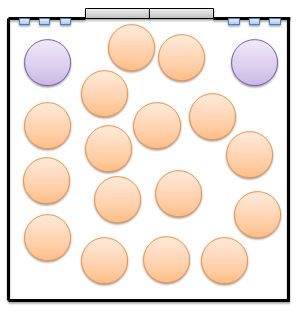 I will come back to the Gatekeepers in just a second when we get to what happens at the end of the elevator ride and there are still two Gatekeepers left.
I will come back to the Gatekeepers in just a second when we get to what happens at the end of the elevator ride and there are still two Gatekeepers left.
The-Guys-With-The-Most-Annoying-Place-Ever & The Annoyer
Usually these two roles interact all the time with each other in an elevator. For the sake of this post and your eyes we will call The-Guys-With-The-Most-Annoying-Place-Ever simply TG-APEs (because it sounds so nice and is so short). The TG-APEs are the ones who came in last and have the honor of standing EXACTLY in front of the doors running the risk of getting their noses being cut off by the doors. While in Germany or Mexico people will usually just try to squeeze their way out when they are NOT standing exactly in front of the doors, Japanese have quite the different approach to this.
Maybe a few of you noticed or know; but Japanese don’t like physical contact, it is avoided as much as possible in public and reserved for family and close friends only (if at all) (And again: THERE ARE EXCEPTIONS! I have some very touchy friends here). In the case of elevators in Japan (and the same procedure applies to trains in Japan as well) the first row of people who isn’t getting off – but was blessed with being the chosen ones in front of the doors – has to step out and in, out and in, out and in until they have to get off themselves or they run out of people behind them. You don’t wait for people to say “すみません” (sumimasen – sorry). If you are the first row and it is not your floor: you step out and wait for people to leave the elevator, and step in again (and hope the Gatekeepers are doing their job well and don’t close the doors before you can get back in).
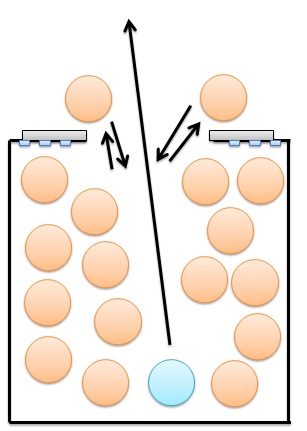 The Annoyer who I mentioned before is depicted in my sketch as the light blue circle. This person knew that he/she would probably get off in the first few floors but still decided to crawl all the way to the back of the elevator, enjoying the luxury of leaning his/her back against the elevator wall. The elevator stops and you hear this tiny little voice from way back saying: “すみません!” (sumimasen – sorry) and the Annoyer will part the people in the elevator like Moses parted the sea to rescue the Israelis from the Egyptians. Imagine 20 people stuck in this small elevator, almost impossible to move. Most of them don’t like being touched! But you have to move together in order to let this ONE person through.
The Annoyer who I mentioned before is depicted in my sketch as the light blue circle. This person knew that he/she would probably get off in the first few floors but still decided to crawl all the way to the back of the elevator, enjoying the luxury of leaning his/her back against the elevator wall. The elevator stops and you hear this tiny little voice from way back saying: “すみません!” (sumimasen – sorry) and the Annoyer will part the people in the elevator like Moses parted the sea to rescue the Israelis from the Egyptians. Imagine 20 people stuck in this small elevator, almost impossible to move. Most of them don’t like being touched! But you have to move together in order to let this ONE person through.
I won’t lie to you. I try to get always to the back of the elevator, this spares me from the responsibility of the Gatekeeper and the TG-APEs. But in my building there are 26 floors and mine is the 25th so usually it is pretty empty when I get there and I won’t be the Annoyer for anyone 😉
Four: Is it your turn to get out?
While in a client and important manager situation there are certain rules (as mentioned above – go and buy a book!), in normal situations you will leave the elevator depending on your own location within this little metal box. This happens often when going down to the ground floor and all people in the elevator leave the elevator at the same time. When going up this is usually less a problem and we have the TG-APEs and Annoyer situation.
The first step is pretty easy because people directly in front of the doors (draw a mental line, parallel to the walls), who are not part of the last row of people, will leave first. See my sketch below.
When this is accomplished a rather weird and embarrassing situation can happen. The elevator will look like the following sketch:
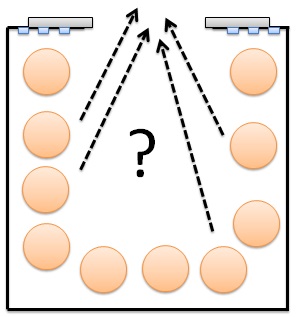 Only people standing at the elevator walls are left. Who is the first one to walk out without bumping into someone else? I have witnessed this situation many times. Everyone is staring at each other but no one is moving. In one of these cases I actually laughed very hard and earned many weird looks by my Japanese co-elevator-riders. It was just too stupid in my eyes. Everyone tried to be the nicest person and going out last which resulted in no one moving for what seemed like an eternity until I left the elevator first – giggling (obviously. Damn gaijin).
Only people standing at the elevator walls are left. Who is the first one to walk out without bumping into someone else? I have witnessed this situation many times. Everyone is staring at each other but no one is moving. In one of these cases I actually laughed very hard and earned many weird looks by my Japanese co-elevator-riders. It was just too stupid in my eyes. Everyone tried to be the nicest person and going out last which resulted in no one moving for what seemed like an eternity until I left the elevator first – giggling (obviously. Damn gaijin).
In countries like Mexico and (sometimes) Germany, we have the rule “Ladies first” and this reduces the possible outcomes of weird situation by a certain amount, but still… it can end up awkward sometimes. Usually it should be like this:
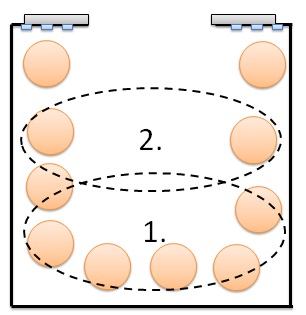 From back to front you leave the elevator, Gatekeepers being the last ones to leave. The only weird moment appears, when people who are at the same vicinity to the exit on opposite sides. They will (again) stare at each other even though they could leave at the same time because it is a two-man-door. But they prefer leaving one after another. Just do us all a favor and leave first. You save a lot of time by just being the one who doesn’t wait.
From back to front you leave the elevator, Gatekeepers being the last ones to leave. The only weird moment appears, when people who are at the same vicinity to the exit on opposite sides. They will (again) stare at each other even though they could leave at the same time because it is a two-man-door. But they prefer leaving one after another. Just do us all a favor and leave first. You save a lot of time by just being the one who doesn’t wait.
The last weird moment is when the Gatekeepers are left to fend for themselves:
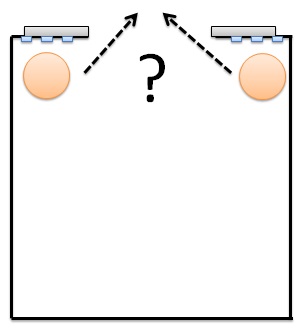 They are pushing the buttons to keep the doors open! I do NOT think that Japanese do NOT know this but: Elevator doors will be open long enough after stopping to push the “open” button, so that both could comfortably leave without getting their legs cut off by closing doors.
They are pushing the buttons to keep the doors open! I do NOT think that Japanese do NOT know this but: Elevator doors will be open long enough after stopping to push the “open” button, so that both could comfortably leave without getting their legs cut off by closing doors.
I assume that they just want to be nice again and not raise the probability of this bloody event to actually happen (not even if the probability would be increased by just 0.0001%). You will keep nodding to the other guy so he gets off first, but he will start nodding too and you will be nodding at each other for a few seconds until you can final leave the elevator. But you press the open button as long as your arm is while getting out of this metal deathtrap. Weirdest pose ever.
I hope I could explain you why it is sometimes rather hard to ride an elevator in Japan and not very relaxing if many people are with you in the elevator. But maybe you are prepared now for your first elevator ride in Japan.
Did it help you? Do you like these kind of posts? Wanna see something else? More questions? Are your countries different? And did you have a very different experience here in Japan? Let me know in the comments below!
I hope you enjoyed this post,
Jonathan
